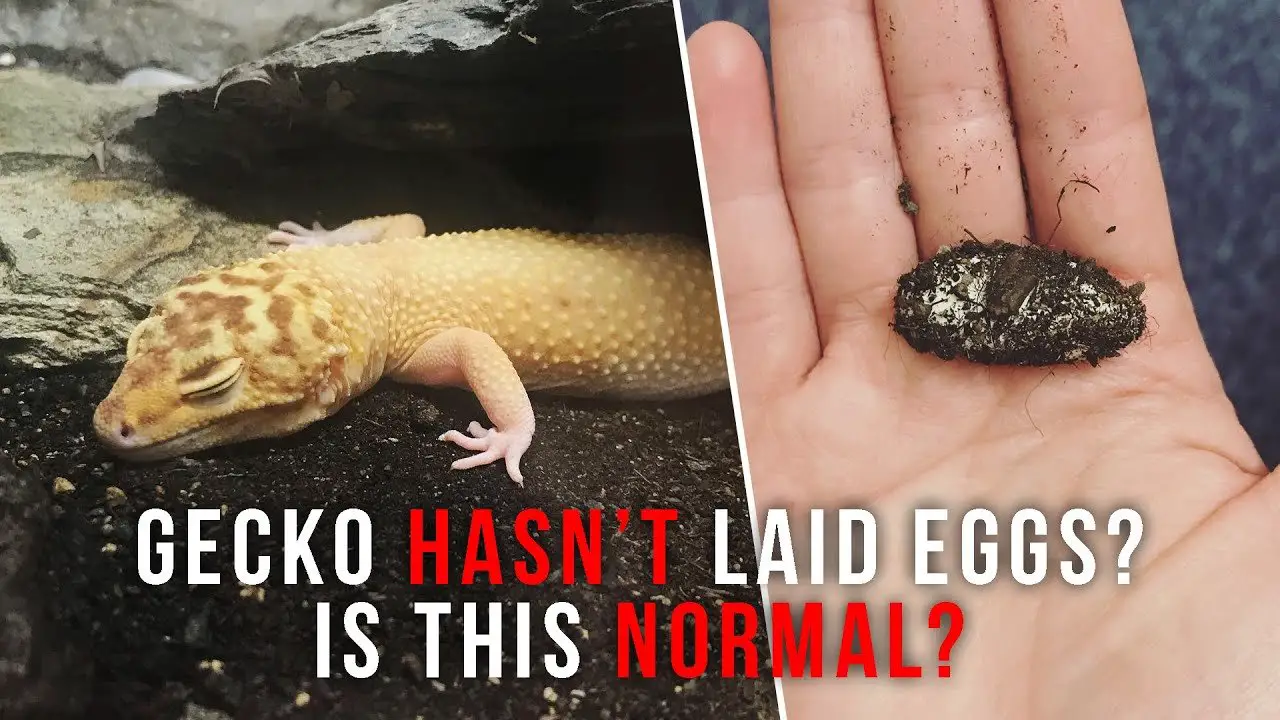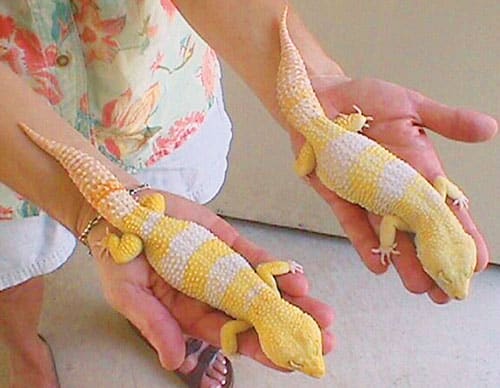How Often Do Leopard Geckos Lay Eggs

Leopard geckos are well-known for their ability to lay eggs, and they usually lay two at a time. The frequency with which they lay eggs varies depending on the individual leopard gecko, but it is generally every other month or so. Some leopard geckos will lay more frequently if they are well-fed and have access to good hiding spots, while others may lay less often if they are stressed or not in ideal conditions.
In general, though, leopard geckos are pretty reliable when it comes to laying eggs!
If you’re wondering how often leopard geckos lay eggs, the answer is typically 2-3 times per year. However, some geckos may only lay one clutch of eggs per year, while others may produce up to four clutches. The number of eggs laid in each clutch can vary greatly, from as few as two to over 20.
The exact timing of when a leopard gecko will lay her eggs depends on several factors, including her age, health, and the temperature and humidity levels in her enclosure. Generally speaking, younger geckos and those that are in good health tend to lay more frequently than older ones or those that aren’t feeling well.Leopard geckos typically deposit their eggs in small holes or crevices that they dig themselves.
Once the eggs are laid, the female will cover them with substrate (sand, soil, etc.) to help keep them moist and protected until they hatch.If you have a leopard gecko as a pet, it’s important to provide her with an appropriate laying site so she can deposit her eggs safely. A small plastic container filled with sand or soil and topped with a piece of cardboard or paper towel makes a great laying site.
Just be sure to punch a few small holes in the lid of the container for ventilation.

Credit: reptilesmagazine.com
How Many Times a Year Do Leopard Geckos Lay Eggs?
Leopard geckos lay eggs approximately 2-3 times per year. Each clutch typically consists of 2-6 eggs, with occasional clutches containing up to 10 eggs. Hatchlings typically emerge from their eggs after 60-75 days of incubation.
How Often Do Leopard Geckos Lay Eggs Without Mating?
Leopard geckos are parthenogenic, meaning they can lay eggs without mating. This is because they have two X chromosomes instead of the usual XY combination found in most other vertebrates. Parthenogenesis is relatively common in reptiles and insects, but it’s relatively rare in mammals.
Female leopard geckos will usually lay one to three clutches of eggs per year, with each clutch containing two to eight eggs. The eggs take around six to eight weeks to hatch, and the young geckos are independent from birth.So, if you’re keeping a female leopard gecko as a pet, you don’t need to worry about finding her a mate – she can go it alone!
Do Leopard Geckos Lay Eggs Randomly?
Leopard geckos are oviparous, meaning they lay eggs. Unlike many other reptiles, leopard geckos do not lay their eggs randomly. Female leopard geckos will often select a specific spot to lay their eggs, and will return to this spot each time they produce a clutch of eggs.
This spot may be in their enclosure, or it may be in a hidden location that the female has chosen outside of her enclosure.The female leopard gecko will typically lay two clutches of eggs per year. Each clutch usually consists of 2-6 eggs, but can occasionally contain up to 10 eggs.
The size of the clutch is generally determined by the size and age of the female leopard gecko.Once the female leopard gecko has laid her eggs, she will carefully cover them with substrate material such as sand or dirt. She will then abandon the Eggs and provide no further parental care.
Can Leopard Gecko Lay Eggs Without Mating?
Yes, leopard geckos can lay eggs without mating. This is called parthenogenesis, and it occurs when an egg develops without being fertilized by a sperm cell. Parthenogenesis is common in reptiles and invertebrates, but it’s rare in mammals.
Leopard geckos are one of the few mammal species that can reproduce via parthenogenesis.There are two types of parthenogenesis that can occur in leopard geckos: haploid and diploid. Haploid parthenogenesis results in eggs that have half the usual number of chromosomes (n).
These eggs can only develop into males. Diploid parthenogenesis results in eggs that have the usual number of chromosomes (2n). These eggs can develop into either males or females.
So, if you have a female leopard gecko who has never been mated, she may still lay fertile eggs that will hatch into healthy baby geckos!
Do ALL Female Leopard Geckos LAY EGGS? Is This Normal?!
How Many Eggs Do Leopard Geckos Lay in a Season
Leopard geckos are a popular pet for reptile enthusiasts. They are relatively easy to care for and make great first pets. One of the most common questions new leopard gecko owners have is “How many eggs do leopard geckos lay in a season?”
The answer to this question depends on a few factors, including the age of the gecko and the conditions under which they are kept. A healthy adult female leopard gecko can lay 2-3 clutches of 2-6 eggs per season. If the conditions are ideal (e.g., temperature, humidity, food availability), a female leopard gecko may be able to produce 4-5 clutches per season.
However, if conditions are not ideal, she may only produce 1-2 clutches.The number of eggs laid per clutch also varies depending on the age of the female and the conditions under which she is kept. A younger female or one that is not well-nourished is likely to lay fewer eggs per clutch than an older, healthier female.
Similarly, if environmental conditions are not ideal (e.g., too hot or too cold), this can also affect egg production, with females laying fewer eggs per clutch than they would under optimal conditions.
Do Leopard Geckos Lay Eggs Without a Male
Yes, leopard geckos can lay eggs without a male. This is called parthenogenesis, and it occurs when the female’s egg develops without being fertilized by a male’s sperm. Parthenogenesis can happen spontaneously or it can be induced by certain environmental conditions, like temperature changes.
When this happens, the resulting offspring are all clones of the mother and they’re all female.
How Often Do Leopard Geckos Lay Infertile Eggs
Geckos are well-known for being one of the most prolific egg-layers in the reptile world. A single female leopard gecko can lay upwards of 10 eggs in a single clutch, and she can produce 2-3 clutches per year! However, it’s important to note that not all of these eggs will be fertile.
In fact, it’s estimated that only about 50% of leopard gecko eggs are fertile. This is due to a variety of factors, including poor husbandry, genetic defects, and simple bad luck.If you’re hoping to breed your leopard geckos, it’s important to do your research and make sure you’re providing them with the best possible care.
Creating a proper breeding setup is vital for giving your geckos the best chance at producing fertile eggs. And even then, there’s no guarantee that every egg will be viable. But don’t get discouraged – with patience and diligence, you may just end up with a few healthy baby leopard geckos!
What is the typical egg-laying behavior of reptiles?
Reptiles exhibit diverse egg-laying behaviors, and turtle egg laying facts offer fascinating insights. Female turtles carefully select suitable nesting sites, digging holes in sandy or soft soil. They lay their eggs, cover them up, and return to the sea, leaving the nest unattended. Temperature affects the gender of the hatchlings, with warmer temperatures producing more females.
Leopard Gecko Breeding Season
Leopard geckos are generally ready to breed by the time they reach 18 months old. The breeding season for leopard geckos typically runs from March to October, with peak activity occurring in May and June. If you’re thinking about breeding leopard geckos, it’s important to do your research ahead of time and make sure you have the proper setup for your animals.
During the breeding season, male leopard geckos will become more aggressive and territorial. They may start fighting with each other if there are multiple males in the same enclosure. To avoid problems, it’s best to house only one male per enclosure during the breeding season.
Females can be housed together without issue.When pairing up leopard geckos for breeding, it’s important to choose animals that are of similar size and age. Avoid pairing up very young animals or those that differ greatly in size, as this can lead to problems during mating and egg production.
Once you’ve chosen your pairings, you’ll need to set up separate enclosures for each pair so they can mate in privacy.The gestation period for leopard geckos is typically 45-60 days long. During this time, it’s important to provide the female with a calcium supplement to help her produce strong eggs.
After she lays her eggs, she should be removed from the male’s enclosure so he doesn’t eat them! The eggs should be incubated at a temperature of 82-86 degrees Fahrenheit until they hatch (usually within 50-70 days).Congratulations – if all goes well, you’ll soon have baby leopard gecko hatchlings!
Be prepared for them by setting up a separate enclosure with plenty of hiding places where they can feel safe and secure. Provide them with a diet of small insects and offer a calcium supplement just like their mother had while she was pregnant. With proper care, your baby leopards will thrive and grow into healthy adults!
Conclusion
Leopard geckos are a type of lizard that is found in the wild in parts of Asia and Africa. They are also popular pets in many parts of the world. Female leopard geckos can lay eggs even if they have never been mated with a male.
This is because they are capable of storing sperm from males that they have mated with in the past. As a result, female leopard geckos will usually lay a clutch of eggs every few months regardless of whether or not they have been recently mated.